Pistol development in the early 1900s was rapid. Pistols were being spit out at a rapid rate, and it seemed that almost every other year, some new advancement would be made in the technology.
In 1900, we got the first semi-auto pistol with a slide, and by 1911, we had the M1911. That’s how fast things were moving, and by the 1930s, the semi-automatic pistol was fast becoming the choice of military and police forces across the world.
In the 1930s, Walther was eating the European cake for pistols with the PP series. Not wanting to be left behind, famous arms manufacturer Mauser created the Mauser HSc.
The Mauser HSc – The Forgotten German Pistol (By Way of Italy)
The Mauser HSc was a lot like the Walther. It was a standard blowback-operated pistol that chambered .32 ACP or .380 ACP. The gun feeds from a simple single-stack magazine. The action utilized a DA/SA design with a slide-mounted safety and exposed hammer. I’d use that same description to describe the Walther PP series as well.
Mauser released the HSc in 1940s Germany. That was a helluva time to introduce a handgun, but it guaranteed purchases by German police forces, as well as the German Army and Navy.
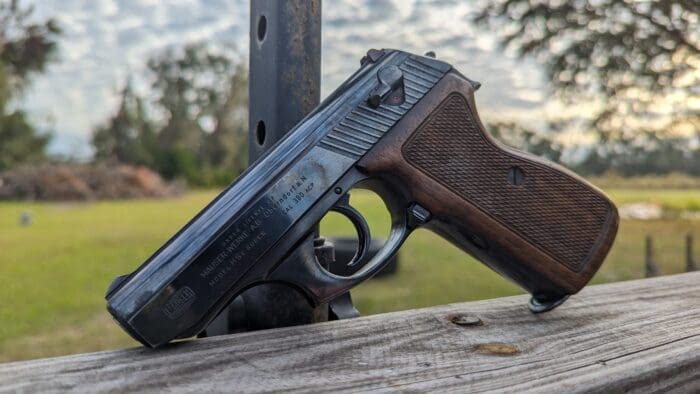
The Mauser HSc joined a long line of pistols that armed the Nazi war machine. The arm purchased 137,000 handguns, and the Navy purchased a little over 27,000 of the handguns, as well as nearly 30,000 purchased by police forces. Another nearly 60,000 were sold on the commercial market. It’s easy to say that the HSc was a very successful pistol, but it’s not one most Americans have had much experience with.
While the HSc is sort of odd, but the HSc Super is even more obscure. After the war, the French produced the HSc for use in the first Indochina War. An Italian firm, Renato Gamba, picked up production and produced the Mauser HSC Super, a.k.a. the HSc Mod 80, a.k.a. the SAB-2001 Super. The HSc Super was intended to provide the commercial market with an advanced version of the Mauser HSc. The gun was old in .32 ACP, .380 ACP, and 9mm Ultra.

What’s So Super About the Mauser HSc?
The HSc Super got rid of the HSc’s single-stack magazine in favor of a double-stack mag. Chambered in.380 ACP, that made room for ten rounds. The .380 version of the HSc Super is the most common variant, but man, I would really love the .32 ACP variant.
The Italians also moved the magazine release from the heel up to the trigger guard. Other than that, it’s not much different than the standard HSc.
The Italians make it a beautiful gun. The glossy blued finish and the wood grips give it some old-school charm. It’s very simple in its design and has the curves of yesteryear rather than the blocky polymer designs we have these days.

Mine was imported by Interarms, who blithely marked up at beautiful, glossy slide with a giant roll mark. The gun comes with massive wooden grips. The Mauser HSc Super’s grip is nearly 1.5 inches wide. It’s absolutely absurd for the size of the pistol and wastes all of the svelteness of the original HSc.
It appears that these guns were imported with both plastic grips and wood grips. The plastic grips aren’t a wrap-around type and seem to be a much thinner option.
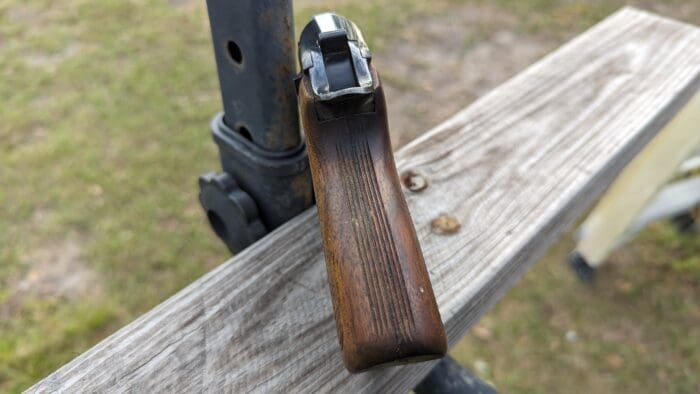
The hammer is interesting as it’s a weird sealed system. I’m not sure what to call it. A small protrusion allows you to de-cock and cock the gun easily. Speaking of safety, it’s not a de-cocker. It can be carried cocked and locked, or you can push the safety on and de-cock the hammer with your thumb without worrying about it slipping and the gun firing.
At the Range
The Mauser HSc Super is a straight blowback .380 ACP without a Hi-Point-sized slide. I’ll admit I thought the gun would have a lot more recoil to it. Those big wide grips and the pistol’s nearly two-pounds of weight soak it all up. It has a little less recoil than a 9mm with a short recoil system.
The HSc Super’s sights are small, but useable and a dab of nail polish would make the front sight stand out. The double-action trigger pull is very heavy and very long. We’re looking at a pull weight of around 12 pounds and a long, but surprisingly smooth trigger pull.
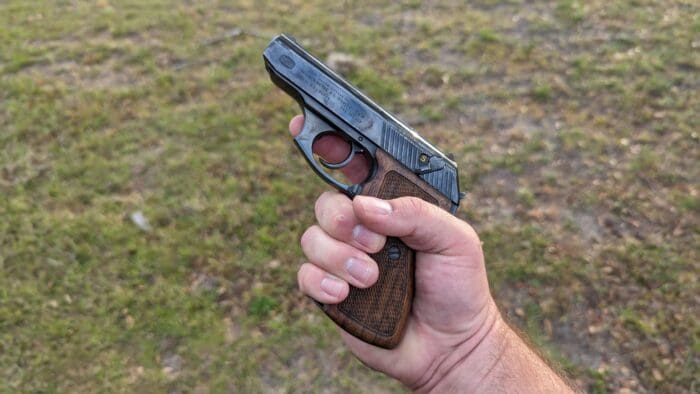
The single action pull has some initial takeup but then a wall and a short break. I love the single action personally, and it’s the reason why the Mauser HSc is so damn accurate.
Those small sights and shortish sight radius should result in a gun that’s made more or less confined to up-close shooting. I started at ten yards and threw lead at a small 4-inch gong and kept it swinging. I stepped back to 15, then 20, and even 25 yards and could still hit that 4-inch gong.
Longer ranges slowed myriad split times, but I still heard that ding almost every time the trigger was pressed. I dropped lots and lots of rounds on the target and really enjoyed the accuracy of this pistol.
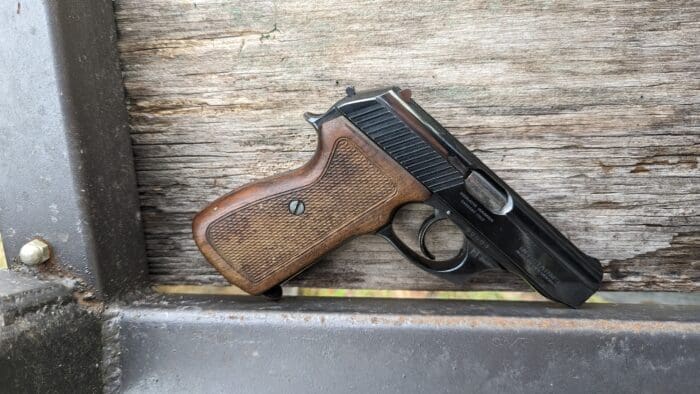
Reliability wasn’t a concern. I used some basic Fioochi 90-grain ammo, and it all went bang. I rarely enjoy shooting blowback-operated .380 pistols, but the Mauser HSc Super surprised me.
A Quirky .380
The HSc Super has a few quirks. The slide locks open after the final round is fired, which is great. However, there’s no slide release. You might think, ‘I’ll just slingshot it.’ Don’t worry, you don’t need to! Just insert the loaded magazine, and it automatically closes the slide. If you want to close the slide without loading a live round, don’t worry, inserting an empty magazine will also drop the slide.

The biggest downside to the HSc Super is the magazine release. Any other handgun in the world is pretty simple. Just press it inward, and the magazine drops. With the HSc Super, the magazine release doesn’t go inward but needs to be pressed backward. You can’t reach it with your firing hand thumb, so it takes your support hand to release the magazine. No, really.
The New .380s
Not that long ago, .380s were pocket pistols…and they were mostly terrible. The .380 ACP has returned to tradition in many ways in the modern era. Guns like the Beretta 80X Cheetah, the P365-380, and the Ruger Security .380 ACP have revived the concept of the compact .380 ACP. Browning designed the .380 ACP for moderately sized pistols like the M1909 Pocket Pistol, and in our eternal wisdom, we thought that would translate well to 10-ounce pocket pistols.
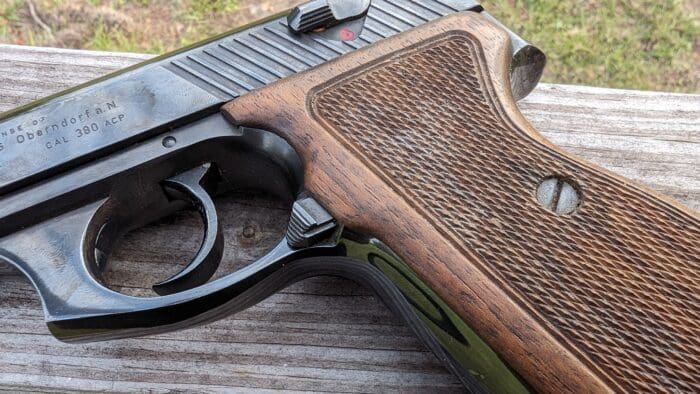
In the modern era, the .380 ACP is seeing a revival in this return to tradition as a low-recoiling cartridge for a compact handgun, and the Mauser HSc Super is an old-school option in that same genre. These guns seem to be selling for around 300 bucks. I got mine for 280 bucks with a single magazine. If holsters were easy to find, this would be a viable carry option. I’d probably toss on some plastic grips to cut the grip size down. It’s not modern, but it’s very capable, reliable, and clearly a very well-made pistol you can still find at a good price.

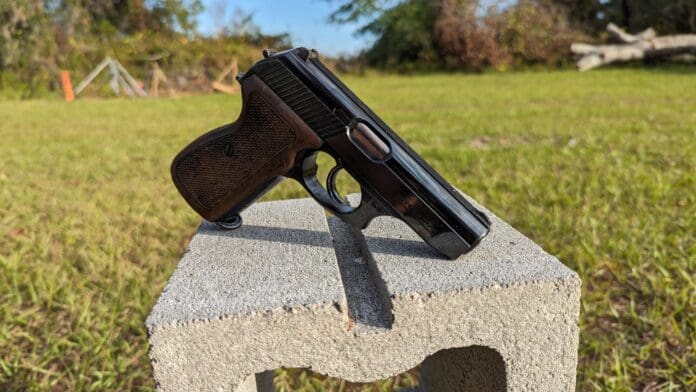



Don’t know where one was sold for under $300.
The only ones I find are $500+.
A friend had one of these years ago. It shot well, but I preferred the PPK/S I had at the time.
Finally an “object of desire” I have an interest in.
Don’t dry fire an HSc. Their firing pins are prone to breakage due to a radical change in section.
Not certain replacements are still available. The Interarms inventory of spare parts was sold off 20 years ago.
Meh I’ll take a Makarov, or even the excellent slim Radom P-64. 9x18mm packs a decent punch advantage over 9x17mm and maybe someday cheap mak ammo will become available again after the disruptive Ukie war is over and the courts overturn the import bans.
(sigh) A .380 auto is not much more than a bee sting. For self defense minimum is a 9mm
That’s an odd way of telling us you don’t know anything about terminal ballistics and handguns.
Travis, Oh, on the contrary. If you are standing with in a few feet you might (stress might) stop the threat, but further than that is not much more than a bee sting.
Seems you “think” you know about “terminal balistics” ? What do you think a .40S&w can do? And inspite of what some think, a full size GLOCK is just as concealable as one of your “midget guns”. But you have to know what you are doing.
Temrinal ballistics in terms of hanguns? They just poke holes. Stopping power is a myth. Enery on target means nothing with a handgun. Hydrostatic shock doens’t occur with handguns, and neither do secondary wounding effects. A handgun just pokes a hole. The hole needs to be deep enough to stirke something vital. A .380 ACP from the Mauser can reach deep enough to do just that. The shooter needs to do their job. A .380 JHP can expand form the Mauser, but expansion is a very distant second to proper penetration.
What does 40 S&W do? The same thing, but with more recoil.
.380 will do some damage.
:Some” may not stop the treat.
I have never owned a HSC Super but have owned 3 of the standard Hsc models, two .380’s and now presently a .32 acp.
The Mauser’s feed ramp is steep which prevented me from shooting any cast bullets out of the .380 models and any hesitation in the feeding cycle allowed the firing pin to come out of the slide because of its weak spring and catch a round coming up out of the magazine resulting in either a jam or broken firing pin. Strangely enough I have been able to shoot cast bullets out of my .32 acp Hsc.
Shooting Times Magazine years ago reported that the .380 model they tested cracked its frame even though the gun was brand new. It seems Mauser did not adequately reengineer the gun when they rechambered it from the original caliber which it was designed for which of course was the .32 acp. In comparison to the Walther PP pistol I have shot some hellish overloads out of several .380 Walther PP pistols that did the guns no harm but actually warped the frames on an FN Browning 1955 and a Browning 10/70 pistol. Lesson learned: Never fire Plus P .380 loads out of the Brownings or a Mauser HSC but the Walthers eat them up faster than a Bass swallows a Bluegill.
The double action pull on the 3 guns I have used was unmanageable due to the very heavy pull but the single action pulls were very good although slightly less crisp or as light than the Walther PP series of pistols.
Accuracy was outstanding and equaled much to my surprise the accuracy of my Walther PP pistols even though the Mauser barrel is not fixed to the frame.
Sights were on the small side but hey its a hideout pocket pistol not a target gun.
I have always liked the rakish styling of the front portion of the frame although it does add unnecessary weight to the gun.
The automatic loading when inserting a fresh magazine was always a plus for me although some people panic when they first experience this type of design.
This weapon was original developed to compete with the Walther PP series of pistols and was actually cheaper to produce but it fell short of the performance of the Walthers. As one can see it reliability and its durability never matched that of the Walther PP series of pistols. Still compared to todays plasticky trash pistols its still a Cadillac of a hideout pistol if you stick with its original .32 acp caliber.
And by the way the reason the Germans adopted the .32 acp instead of the .380 was that the .32 acp would penetrate a military helmet while the .380 would not. So much for the myth that the .32 acp was inferior to the .380 caliber.
How is it that a guy that fully supports gun control, as you do, claims to own so many guns. You must have a warehouse full of safes to hold all the guns you’ve claimed to own here, dacian.
Typical liberal hypocrite is hypocritical
He has guns alright but instead of safe, closet, or nightstand his are kept in a folder on his computer titled “Wikipedia Firearms Pages”.
In other words, not much good for self defense.